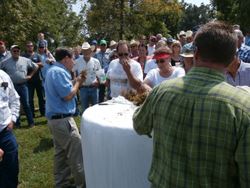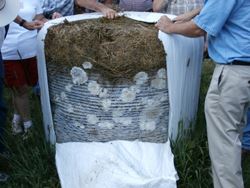|
Beef-Forage Tour At SW Center Well Attended
MT. VERNON, MO.
The Southwest Missouri Cattlemen’s Association, University of Missouri Extension and the University of Missouri’s Southwest Research Center teamed up for a successful educational event at Mt. Vernon on Saturday, Aug. 24.
The tour of the beef and forage activities on the farm was led by Dr. Rob Kallenbach, State Extension Forage specialist. He was assisted by Brett Jones, a graduate student at MU.
The first stop featured six, big round bales wrapped in plastic. The forage in each were similar, the difference was in their management. One bale was too dry when wrapped, one was too wet, one was wrapped with only one wrap, one bale’s wrap had been punctured, one was not wrapped for 48 hours and finally one bale was managed properly.
“Rob split the plastic on each bale and invited everyone to smell, feel and evaluate the haylage. As expected, only one bale’s contents really ended up as excellent feed that would not result in waste,” said Eldon Cole, a livestock specialist with MU Extension.

(Top Photo) “Show and Smell Time” – odor or aroma is important as Dr. Kallenbach
demonstrates to the audience.
(Photo Below) A bale that was too high in moisture when wrapped.

Questions were raised about feeding moldy haylage. Kallenbach said there is very little risk because the cows generally sort through it and the moldy material becomes waste.
“He said you should wrap the hay at 40 to 60 percent moisture and to use a reliable moisture tester. Wrap the bales as soon as you can, certainly within 24 hours, using multiple wraps,” said Cole.
Haylage doesn’t store well beyond one year and haylage needs to ensile for 3 to 6 weeks before feeding.
The next stop was at the beef barn where the Grow-Safe unit is used to evaluate Residual Feed Intake (feed conversion) on both beef and dairy cattle.
The heifers seen are fed either Kentucky 31 fescue with toxic endophyte or Bar Optima Plus, a fescue with the friendly or novel endophyte. A portion of the heifers on each haylage have some tolerance to fescue toxicity while the others do not.
“From there, we visited one of the replicated KY31 and Bar Optima Plus pastures being grazed by fall-calving cows. The latter cows were out in the sun on the 90 degree day and had slick hair coats. In contrast the KY31 cows were under the shade with longer, rough hair coats and were reluctant to get out in the sun,” said Cole.
The cows on these pastures were of different genotypes regarding fescue toxin sensitivity. The genotyping is done by University of Tennessee researchers.
“Rob stressed that in combating fescue problems think, fungus first and selection second so far as forage and genetics are concerned,” said Cole.
During the pasture stops, Kallenbach and Jones demonstrated how pasture growth is measured as they develop a grazing wedge for each pasture. Their system uses a four-wheeler, a computer, GPS and a software program.
“This combination of technology allows measurement to be taken 20 times per second as the four-wheeler speeds over the pasture in a zig-zag pattern. They said it sure beats using a rising plate meter which requires walking each pasture,” said Cole.
The Southwest Center was established in 1957 and covers 897 acres along I-44. Primary research conducted, besides beef and forage, includes pasture-based dairy, a wide variety of horticultural projects and agroforestry.∆
|
|